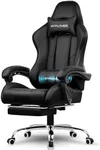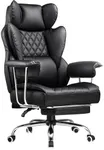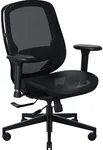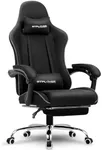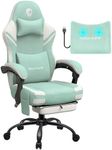Buying Guide for the Best Gaming Chairs
Choosing a gaming chair is about balancing comfort, ergonomics, and style to enhance your gaming sessions while also promoting good posture and health. While gaming chairs may look similar, there are key differences in features and designs that impact how comfortable and supportive they are for different people. It's important to focus on how a chair supports your body, fits your space, and matches your usage habits. Think about how many hours you spend sitting, your body size, and if you need special features, as these will all point you toward the right choice.ErgonomicsErgonomics refers to how well the chair is designed to support the natural shape and movement of your body. This is important because a chair with good ergonomic design can prevent aches, pains, and long-term health issues that come from sitting for long periods. When comparing chairs, look at which offer adjustable lumbar support, headrests, and armrests, as well as seats shaped to follow your body's curves. If you mainly use the chair for short sessions, you might not need all the adjustable features, but for long gaming or work hours, choose a chair that lets you customize support for your back, neck, and arms.
AdjustabilityAdjustability is about how many parts of the chair you can change to fit your body and sitting style, such as seat height, tilt angle, recline range, and armrest position. This matters because everyone's body and desk setup is a little different, and the more adjustable a chair is, the easier it is to make it comfortable for you. Chairs with basic adjustability can raise or lower the seat, but more advanced ones let you tweak everything from armrest angle to the recline tension. If you value a tailored fit or use the chair for both gaming and work, prioritize more adjustment options; if you just want a simple seat for occasional use, basic adjustability may be enough.
Build Quality and MaterialsBuild quality and materials refer to the frame construction, upholstery (such as leather, fabric, or mesh), and the overall sturdiness of the chair. This is important because higher-quality materials tend to last longer, look better, and feel more comfortable for extended sitting. Metal frames are typically more durable than plastic, and breathable fabrics can keep you cooler than leather, especially if you live in a hot area. If you want a chair that will last through many hours of gaming, consider models with strong frames and robust upholstery; for lighter or occasional use, less rugged materials may be fine.
Size and Weight CapacitySize and weight capacity indicate the recommended height, width, and weight limits for users. This spec is important to ensure the chair actually fits your body and is safe to use. Gaming chairs come in different size categories: standard chairs fit most people, but there are also options for bigger or taller users, as well as more compact chairs for smaller spaces. To pick the right one, check the chair's size limit and seat dimensions, and choose a model that accommodates your height and weight comfortably. This helps prevent discomfort and ensures the chair stays sturdy over time.
Seat Padding and ComfortSeat padding and comfort involve how much cushioning is used in the seat and backrest, and how firm or soft it feels. Good padding can make long gaming sessions much more comfortable, but too much or too little can lead to discomfort or lack of support. Chairs with thick, breathable padding generally suit longer sessions, while firmer cushions may be preferred for better back support. If you game for hours at a time, prioritize substantial, supportive padding; if you only sit for short periods, you may be fine with a firmer, more basic seat.
Reclining and Rocking FunctionsReclining and rocking functions describe whether and how far the chair can tilt backward or rock gently while you sit. This is valuable for relaxation during breaks or for finding the perfect sitting angle for different activities. Some chairs recline almost flat for resting, while others have a limited tilt just for comfort. If you like to lounge or nap in your chair, look for a wide recline range; if you stay upright most of the time, a standard or locking recline is probably sufficient.
Armrest TypeArmrest type covers whether the armrests are fixed, adjustable up and down, or can move in multiple directions (forward-backward, left-right, or rotational). This is important because properly positioned armrests can reduce strain on your shoulders and wrists, especially during long gaming or typing sessions. 3D or 4D armrests (adjustable in several directions) offer the most flexibility. If you spend a lot of time at your desk or need to switch between tasks, look for highly adjustable armrests; otherwise, fixed or basic adjustable ones may suffice.
Style and AestheticsStyle and aesthetics refer to the visual design, color, and overall look of the chair. While this doesn't affect performance, it is important if you care about matching your gaming setup or home office. Gaming chairs offer many styles, from bold, racing-inspired designs to more subtle, professional looks. Pick a style that fits your room and personal taste—this can help make your gaming area inviting and enjoyable for the long term.

